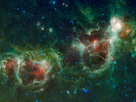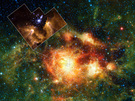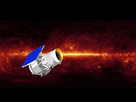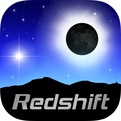NASA's NEOWISE
Scan for Asteroids and Comets
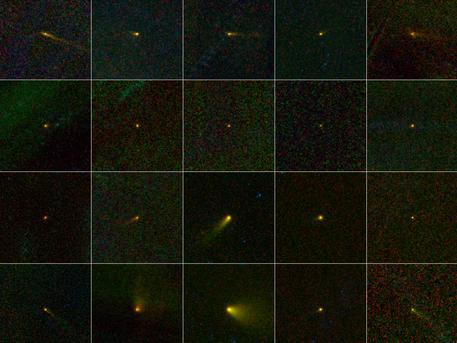 © NASA/JPL-Caltech/UCLA
|
During its one-year mission, NASA's Wide-field Infrared Survey Explorer, or WISE, mapped the entire sky in infrared light. Among the multitudes of astronomical bodies that have been discovered by the NEOWISE portion of the WISE mission are 20 comets. This collage shows those 20 new comets all together in a kind of family portrait. Most of the comets are named WISE. In four cases, the comet does not bear the name WISE because the object was known before to be an asteroid. The WISE observations revealed their true nature. These objects did not turn out to be stony and/or metallic space rocks as is the case for asteroids. Instead, they were shown to be comets -- snowy dust balls with clouds of dust and gas surrounding them. When most people think of comets, they think of the popular images of Halley's Comet or Comet Hale-Bopp, with bright, enormous tails. A comet tail forms as the object travels closer to the sun. The ices in the comet are heated and become a gas, escaping the surface of the comet and lifting dust particles away as well. This fuzzy cloud around the comet nucleus is called a coma. As a comet gets closer and closer to the sun, the solar wind and sunlight push the coma away, forming the long tail. Comets are named by the International Astronomical Union’s Minor Planet Center, and the names indicate the circumstances of discovery. The designations of the comets in the collage, from left to right, top to bottom are: 237P/LINEAR (2002 LN13), 233P/La Sagra (2009 WJ50), P/2009 WX51 (Catalina), P/2010 B2 (WISE), P/2010 D1 (WISE), P/2010 D2 (WISE), C/2010 D3 (WISE), C/2010 D4 (WISE), C/2010 DG56 (WISE), C/2010 E3 (WISE), C/2010 FB87 (WISE-Garradd), C/2010 G3 (WISE), C/2010 J4 (WISE), P/2010 K2 (WISE), C/2010 KW7 (WISE), 237P/LINEAR (2010 L2), C/2010 L4 (WISE), C/2010 L5 (WISE), P/2010 N1 (WISE), and P/2010 P4 (WISE). (Italicized names are the ones that had been previously discovered as minor planets, but were not known to be comets.) The fuzzy background in each picture is due to random fluctuations in infrared light, primarily from dust in our own solar system. Stars cannot be seen because they are subtracted out during the process of combining multiple WISE pictures together to make this view centered on the moving comets. The colors in the pictures are representational. Infrared light of 4.6, 12 and 22 microns is colored blue, green and red, respectively. The light emitted from comets in infrared is due to their temperatures, so the cooler objects appear to have more red, while warmer objects will appear more bluish.
In early October 2010, after completing its prime science mission, the spacecraft ran out of the frozen coolant that keeps its instrumentation cold. However, two of its four infrared cameras remained operational. These two channels were still useful for asteroid hunting, so NASA extended the NEOWISE portion of the WISE mission by four months, with the primary purpose of hunting for more asteroids and comets, and to finish one complete scan of the main asteroid belt.
"Even just one year of observations from the NEOWISE project has significantly increased our catalog of data on NEOs and the other small bodies of the solar systems," said Lindley Johnson, NASA's program executive for the NEO Observation Program.
Now that NEOWISE has successfully completed a full sweep of the main asteroid belt, the WISE spacecraft will go into hibernation mode and remain in polar orbit around Earth, where it could be called back into service in the future.
In addition to discovering new asteroids and comets, NEOWISE also confirmed the presence of objects in the main belt that had already been detected. In just one year, it observed about 153,000 rocky bodies out of approximately 500,000 known objects. Those include the 33,000 that NEOWISE discovered.
NEOWISE also observed known objects closer and farther to us than the main belt, including roughly 2,000 asteroids that orbit along with Jupiter, hundreds of NEOs and more than 100 comets.
These observations will be key to determining the objects' sizes and compositions. Visible-light data alone reveal how much sunlight reflects off an asteroid, whereas infrared data is much more directly related to the object's size. By combining visible and infrared measurements, astronomers also can learn about the compositions of the rocky bodies -- for example, whether they are solid or crumbly. The findings will lead to a much-improved picture of the various asteroid populations.
NEOWISE took longer to survey the whole asteroid belt than WISE took to scan the entire sky because most of the asteroids are moving in the same direction around the sun as the spacecraft moves while it orbits Earth. The spacecraft field of view had to catch up to, and lap, the movement of the asteroids in order to see them all.
"You can think of Earth and the asteroids as racehorses moving along in a track," said Amy Mainzer, the principal investigator of NEOWISE at NASA's Jet Propulsion Laboratory in Pasadena, Calif. "We're moving along together around the sun, but the main belt asteroids are like horses on the outer part of the track. They take longer to orbit than us, so we eventually lap them."
NEOWISE data on the asteroid and comet orbits are catalogued at the NASA-funded International Astronomical Union's Minor Planet Center, a clearinghouse for information about all solar system bodies at the Smithsonian Astrophysical Observatory in Cambridge, Mass. The science team is analyzing the infrared observations now and will publish new findings in the coming months.
When combined with WISE observations, NEOWISE data will aid in the discovery of the closest dim stars, called brown dwarfs. These observations have the potential to reveal a brown dwarf even closer to us than our closest known star, Proxima Centauri, if such an object does exist. Likewise, if there is a hidden gas-giant planet in the outer reaches of our solar system, data from WISE and NEOWISE could detect it.
The first batch of observations from the WISE mission will be available to the public and astronomical community in April.
"WISE has unearthed a mother lode of amazing sources, and we're having a great time figuring out their nature," said Edward (Ned) Wright, the principal investigator of WISE at UCLA.
Source: NASA
NASA's NEOWISE
Scan for Asteroids and Comets
 © NASA/JPL-Caltech/UCLA
|
During its one-year mission, NASA's Wide-field Infrared Survey Explorer, or WISE, mapped the entire sky in infrared light. Among the multitudes of astronomical bodies that have been discovered by the NEOWISE portion of the WISE mission are 20 comets. This collage shows those 20 new comets all together in a kind of family portrait. Most of the comets are named WISE. In four cases, the comet does not bear the name WISE because the object was known before to be an asteroid. The WISE observations revealed their true nature. These objects did not turn out to be stony and/or metallic space rocks as is the case for asteroids. Instead, they were shown to be comets -- snowy dust balls with clouds of dust and gas surrounding them. When most people think of comets, they think of the popular images of Halley's Comet or Comet Hale-Bopp, with bright, enormous tails. A comet tail forms as the object travels closer to the sun. The ices in the comet are heated and become a gas, escaping the surface of the comet and lifting dust particles away as well. This fuzzy cloud around the comet nucleus is called a coma. As a comet gets closer and closer to the sun, the solar wind and sunlight push the coma away, forming the long tail. Comets are named by the International Astronomical Union’s Minor Planet Center, and the names indicate the circumstances of discovery. The designations of the comets in the collage, from left to right, top to bottom are: 237P/LINEAR (2002 LN13), 233P/La Sagra (2009 WJ50), P/2009 WX51 (Catalina), P/2010 B2 (WISE), P/2010 D1 (WISE), P/2010 D2 (WISE), C/2010 D3 (WISE), C/2010 D4 (WISE), C/2010 DG56 (WISE), C/2010 E3 (WISE), C/2010 FB87 (WISE-Garradd), C/2010 G3 (WISE), C/2010 J4 (WISE), P/2010 K2 (WISE), C/2010 KW7 (WISE), 237P/LINEAR (2010 L2), C/2010 L4 (WISE), C/2010 L5 (WISE), P/2010 N1 (WISE), and P/2010 P4 (WISE). (Italicized names are the ones that had been previously discovered as minor planets, but were not known to be comets.) The fuzzy background in each picture is due to random fluctuations in infrared light, primarily from dust in our own solar system. Stars cannot be seen because they are subtracted out during the process of combining multiple WISE pictures together to make this view centered on the moving comets. The colors in the pictures are representational. Infrared light of 4.6, 12 and 22 microns is colored blue, green and red, respectively. The light emitted from comets in infrared is due to their temperatures, so the cooler objects appear to have more red, while warmer objects will appear more bluish.
In early October 2010, after completing its prime science mission, the spacecraft ran out of the frozen coolant that keeps its instrumentation cold. However, two of its four infrared cameras remained operational. These two channels were still useful for asteroid hunting, so NASA extended the NEOWISE portion of the WISE mission by four months, with the primary purpose of hunting for more asteroids and comets, and to finish one complete scan of the main asteroid belt.
"Even just one year of observations from the NEOWISE project has significantly increased our catalog of data on NEOs and the other small bodies of the solar systems," said Lindley Johnson, NASA's program executive for the NEO Observation Program.
Now that NEOWISE has successfully completed a full sweep of the main asteroid belt, the WISE spacecraft will go into hibernation mode and remain in polar orbit around Earth, where it could be called back into service in the future.
In addition to discovering new asteroids and comets, NEOWISE also confirmed the presence of objects in the main belt that had already been detected. In just one year, it observed about 153,000 rocky bodies out of approximately 500,000 known objects. Those include the 33,000 that NEOWISE discovered.
NEOWISE also observed known objects closer and farther to us than the main belt, including roughly 2,000 asteroids that orbit along with Jupiter, hundreds of NEOs and more than 100 comets.
These observations will be key to determining the objects' sizes and compositions. Visible-light data alone reveal how much sunlight reflects off an asteroid, whereas infrared data is much more directly related to the object's size. By combining visible and infrared measurements, astronomers also can learn about the compositions of the rocky bodies -- for example, whether they are solid or crumbly. The findings will lead to a much-improved picture of the various asteroid populations.
NEOWISE took longer to survey the whole asteroid belt than WISE took to scan the entire sky because most of the asteroids are moving in the same direction around the sun as the spacecraft moves while it orbits Earth. The spacecraft field of view had to catch up to, and lap, the movement of the asteroids in order to see them all.
"You can think of Earth and the asteroids as racehorses moving along in a track," said Amy Mainzer, the principal investigator of NEOWISE at NASA's Jet Propulsion Laboratory in Pasadena, Calif. "We're moving along together around the sun, but the main belt asteroids are like horses on the outer part of the track. They take longer to orbit than us, so we eventually lap them."
NEOWISE data on the asteroid and comet orbits are catalogued at the NASA-funded International Astronomical Union's Minor Planet Center, a clearinghouse for information about all solar system bodies at the Smithsonian Astrophysical Observatory in Cambridge, Mass. The science team is analyzing the infrared observations now and will publish new findings in the coming months.
When combined with WISE observations, NEOWISE data will aid in the discovery of the closest dim stars, called brown dwarfs. These observations have the potential to reveal a brown dwarf even closer to us than our closest known star, Proxima Centauri, if such an object does exist. Likewise, if there is a hidden gas-giant planet in the outer reaches of our solar system, data from WISE and NEOWISE could detect it.
The first batch of observations from the WISE mission will be available to the public and astronomical community in April.
"WISE has unearthed a mother lode of amazing sources, and we're having a great time figuring out their nature," said Edward (Ned) Wright, the principal investigator of WISE at UCLA.
Source: NASA





